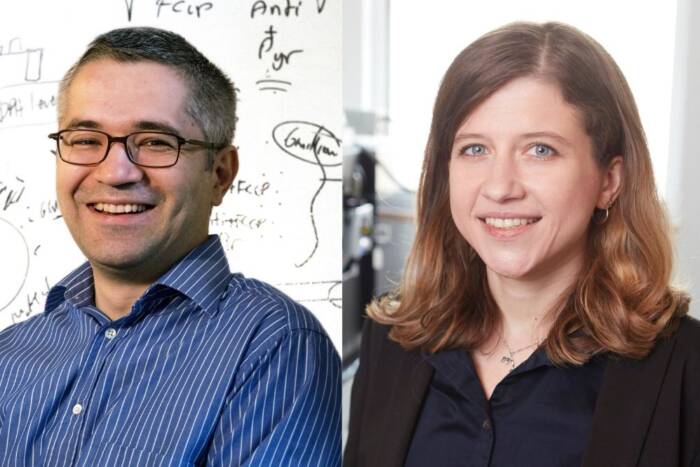Microbiologist to join Rockefeller faculty
A microbiologist who studies how bacterial pathogens modulate the transfer of foreign DNA into their genomes has been named Rockefeller’s newest faculty member. Luciano Marraffini will join the university on July 1 as assistant professor and head of the Laboratory of Bacteriology. His appointment is the second successful recruitment to result from the university’s fall 2009 open faculty search.
Marraffini is interested in understanding the process by which bacteria such as Staphylococcus aureus, the pathogen responsible for hospital-based staph infections, evolve, including how they gain the ability to resist antibiotic drugs. Unlike higher organisms which evolve through the accumulation of mutations in their genes, bacteria primarily acquire new genetic material by incorporating short sequences of DNA from other bacteria or from the environment into their genomes. This process, called horizontal gene transfer, has the advantage of allowing bacteria to quickly adopt successful adaptations, but also carries the risk of introducing deleterious and even lethal DNA to the cell.
“Because the free transfer of foreign DNA can be detrimental to the cell and will prevent the maintenence of the species, bacteria, as many other organisms, must have mechanisms that control the traffic of genetic material,” Marraffini says.
Marraffini studies one such mechanism, known as CRISPR interference, for Clustered Regularly Interspaced Short Palindromic Repeats. CRISPR relies on short sequences of DNA — typically 24 to 48 nucleotides in length — that are transcribed into small RNA segments to selectively block the incorporation of foreign DNA into bacteria, in much the same way that the RNA interference process works in mammals. The segments of bacterial DNA found between two repeats of the CRISPR array is often DNA that has been incorporated from bacteriophage — viruses which invade bacteria — or conjugative plasmids, independent DNA molecules that are transferred between bacteria.
“CRISPR plays a role in determining whether or not these DNA molecules become part of the bacterial genome — it has the power to block bacteriophage infection and plasmid conjugation,” Marraffini says. “My goal is to figure out how they do this. I want to tackle the phenomenon using a variety of techniques in biochemistry and genetics, in order to figure out what are the important genes and protein machinery for this mechanism to work.”
Not only would insight into CRISPR’s mechanism suggest ways in which bacterial evolution could be manipulated, blocking adaptations that would allow deadly pathogens to resist drugs, but the mechanism itself could potentially be harnessed to create useful genetically engineered bacteria. A better understanding of CRISPR would also allow scientists to better interpret the historical record of past phage and plasmid infections contained within the bacteria’s DNA, shedding light on how they have developed over millions of years.
“Luciano is an excellent microbiologist trying to understand how bacteria can be such adaptable organisms,” says Paul Nurse, the university’s president. “His work has shown us how they are able to borrow DNA from other organisms in order to fight their infection and understanding more about this process will ultimately lead to new ways of battling infectious disease.”
Marraffini, a native of Argentina, received his undergraduate degree from the University of Rosario in Argentina, and his Ph.D., in microbiology, from the University of Chicago in 2007. He then moved to Northwestern University, where he is currently a postdoc sponsored by the Jane Coffin Childs Memorial Fund. As a postdoctoral fellow he was the first to demonstrate that CRISPR can prevent plasmid conjugation, a finding that was published in Science in 2008. He has since shown that CRISPR works by targeting the DNA of the conjugative plasmid, not the RNA as many people had suspected; and that the CRISPR mechanism relies on differential complementary DNA sequences from outside the target in order to prevent the bacteria from attacking their own DNA.
At Rockefeller, Marraffini plans to pursue further studies of the CRISPR mechanism in Staphylococcus as well as in other bacteria. But his broader goal is to analyze not only the relationship between bacteria and phages, but between those phages and the humans that host the bacteria they invade. “The technology is available to identify phages and unequivocally assign their hosts within any population of bacteria, including those that exist within our bodies,” Marraffini says. “We know a lot about how these phages impact the bacteria they invade, but what is the effect of a phage infection on the human microbiota? This is an issue that needs to be looked at.
“Rockefeller is the perfect place to ask these questions, and I don’t think any other institution compares. Not only does it have excellent resources, but it has a long history of making innovations in microbiology, and I’m excited to become part of that.”



